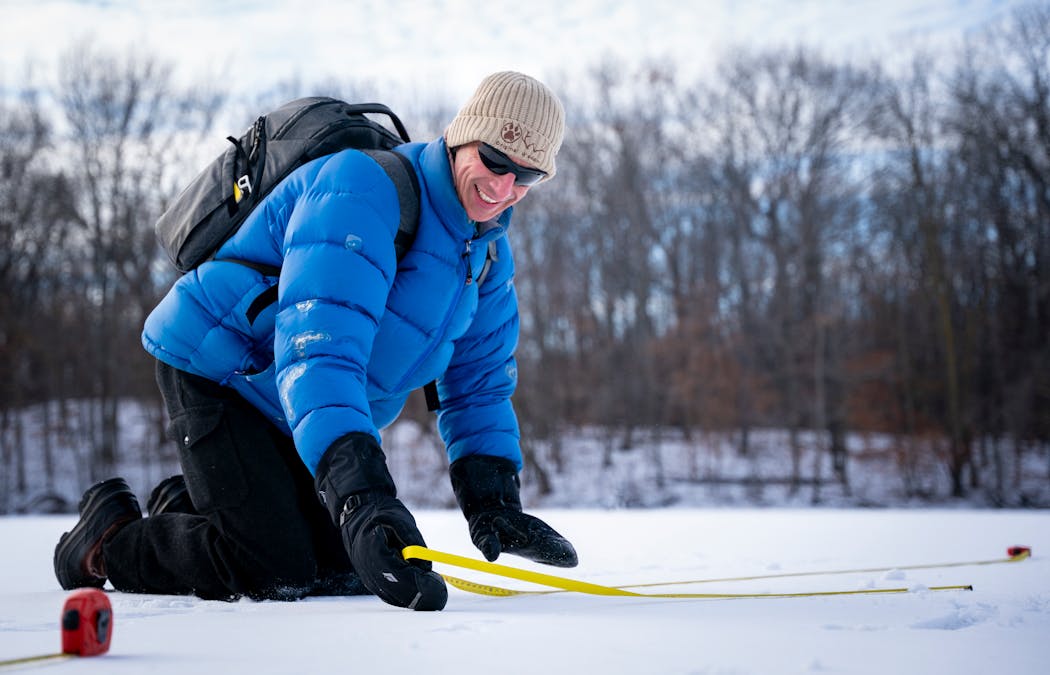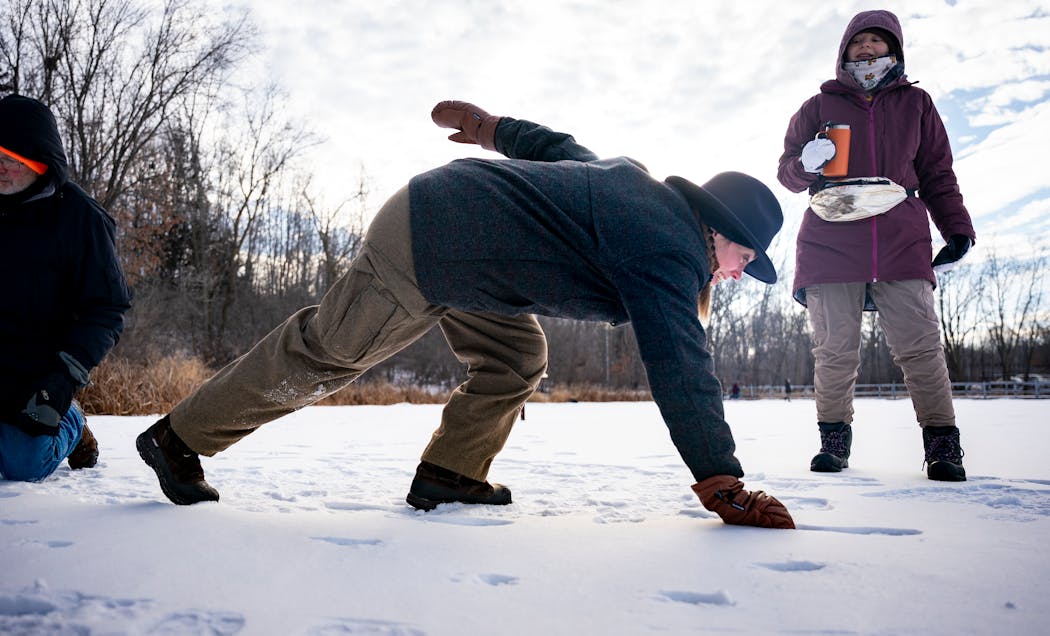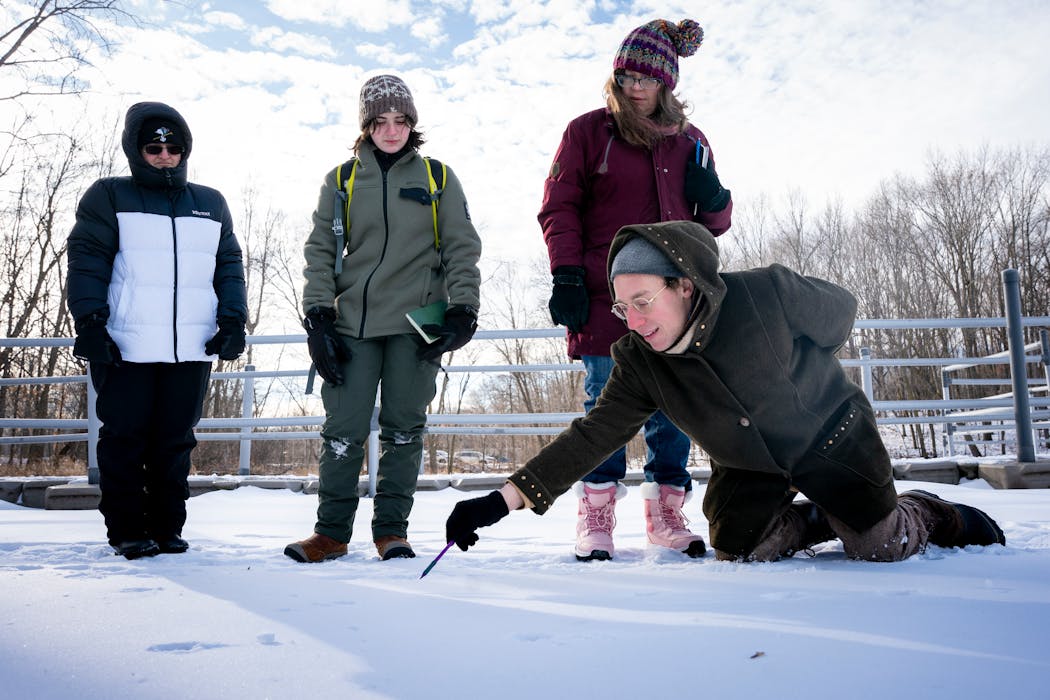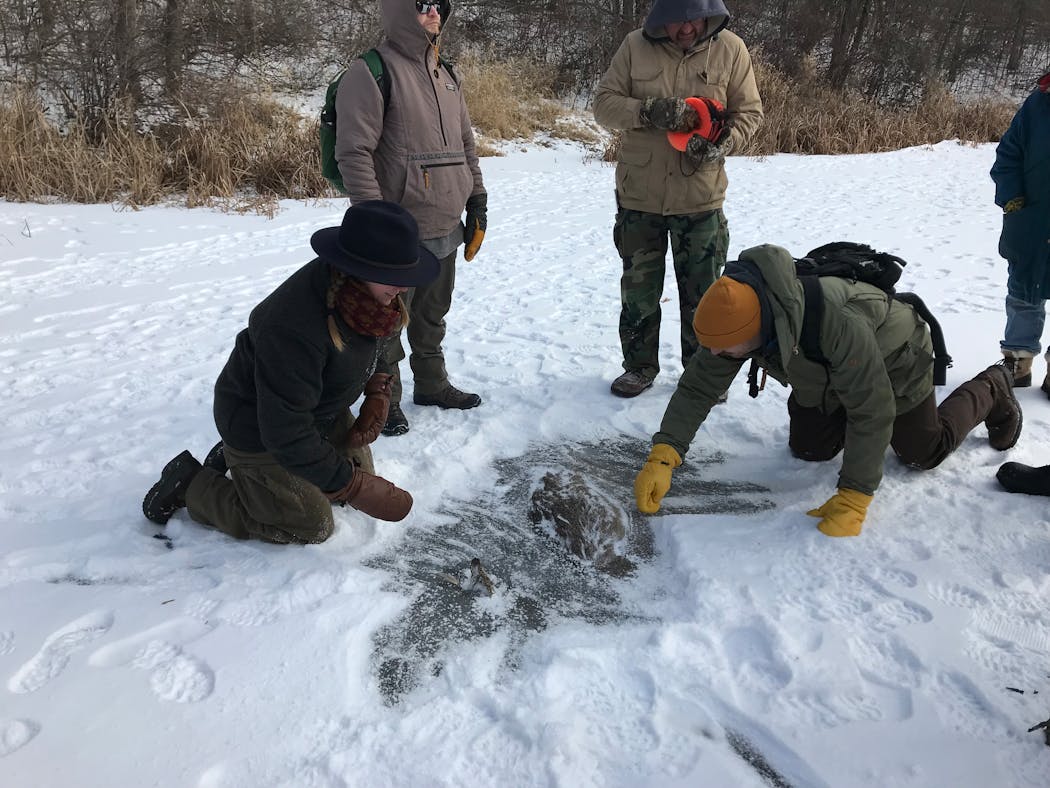It could have been a scene from a "Fargo"-style crime drama: A frozen body partially protruding from a frozen pond. A group of investigators, with tape measures and cameras, studying footprints in the snow. Except one of the clues was a piece of rabbit poop.
That's what happens at an outing of the Minnesota Wildlife Tracking Project, a group of hobbyists and experts interested in the ancient art of animal tracking. Their goal is to hone their skills searching for, identifying and interpreting the tracks and signs that our fellow mammals leave behind in the environment we share.
On a recent and very cold Sunday, they were looking for stories in the snow of the animals that lived — and some that died — at the Elm Creek Park Reserve in Maple Grove.
Tracking is a way to more deeply connect us with nature, according to Jonathan Poppele, a 52-year-old field guide author from St. Paul who started the Tracking Project in 2013.
"Tracking is a window into the lives of the secretive mammals that live around us," Poppele wrote in the guidebook he published in 2012, "Animal Tracks of the Midwest."
It's also a way to connect us to our past.
Poppele says tracking may be "the most ancient of all sciences."
All of us are descended from trackers, early humans who relied on the ability to track animals to put dinner on the table.
"We instinctively are drawn to tracks. We follow tracks. That's part of our human nature," he said. "Because it's such an innate thing for human beings, when we learn it, it feels good."
Modern trackers test their skills by getting certification from Tracker Certification North America, an organization that uses an international standard originally developed in South Africa.
Poppele is a Track & Sign Specialist, the highest level of certification. And about 30 people in the Minnesota Wildlife Tracking Project have some level of tracking certification. The group hosts free monthly outings, typically held on the third Sunday of the month at a local park or wildlife center, with certified trackers leading activities.
About 20 people came to the meeting on Jan. 21 (Squirrel Appreciation Day) at Elm Creek.
Kirsten Welge, a Level 3 certified wildlife tracker from St. Paul, pointed to a set of tracks cutting across a frozen pond near Elm Creek's Eastman Nature Center and asked her fellow trackers to try to decipher what happened based on the clues left in the snow.
"Who left that? What happened here? Which trail is older?" Welge asked. "What are these animals and how are they moving?"
What happened next was like a scene out of "CSI: Minnesota,"with the detectives looking for clues and questioning the motives, opportunities and means of four-footed suspects.
The trackers peered into the footprints in the snow to see if the formation of hoarfrost or sintering of the snow crystals could give them clues on how old the tracks were. They crawled around on all fours to model different animal gaits for each other. The highlight of the morning was when the group found the dead deer.
"It's like a detective story. You can put together clues on what's happening," said Alan Holzer, a naturalist for the Three Rivers Park District who was taking part in the tracking session.
At one set of tiny footprints, the trackers were trying to determine if they had been made by a mouse, a vole or a shrew.
Adrian Iacovino, a Level 2 tracker and an education program coordinator with the Three Rivers Park District, helped out with a literal rule of thumb: If the tracks are one finger-size in width, that's suggests a vole. Two finger widths could be a vole. Three for a short-tailed weasel. Four for a red squirrel. Five for a grey squirrel.
But the trackers wanted to do more than just identify what animal it was. They also wanted to know what it had been doing.
At a set of tracks showing three deer crossing the frozen pond, they discussed the direction and speed of travel, and whether the animals were male or female, adult or juvenile. At a set of tracks on the pond left by a coyote, they noticed one footprint that was out of place and much shallower than the rest. Perhaps it was the spot where the coyote hesitated and looked around just before leaving the ice to run into the brush.
"There's a lot of stories in the snow here," said Bill Kass, a Level 3 tracker who was leading some of the discussions.
"Now I see so much more," said John Bauhs, a retired 3M physicist from North Oaks who has been going to Tracking Project outings for about three years. "I see tracks everywhere."
By looking at a set of tracks in the snow, Bauhs can picture what the animal was doing at that moment. "It's almost like I'm seeing a little bit of a movie."
Trackers also looking for clues to see if the animal was eating, pooping, sleeping, digging, chewing or rubbing against something.
"It's getting an understanding of who these animals are and why they do what they do," said Welge, who teaches tracking, forest bathing and meditation in nature classes with St. Paul Community Education.
Kass pointed out a trail in the snow that suggested a rabbit run. Then he found a neatly cut twig sliced at a 45-degree angle that's characteristic of a rabbit bite. The final confirmation was a single piece of scat that he rolled around in his hand.
"It's so woody and dry," he said. Rabbits eat their poop so they can more fully digest their meals, Kass explained.
Welge said the location, texture, contents and even the smell of animal scat can be helpful in identifying what animal was present.
"It's one of the stinkier parts of tracking and sign, but it tells you so much good information," she said.
Welge even teaches a St. Paul Community Education class for adults and kids about scat identification, which includes a recipe for edible faux animal scat. (We've included her recipe below so you, too, can fool your friends.)
Many of the trackers work in the nature arena. Others participate in citizen science projects, including a daylong wildlife survey at the University of Minnesota's Cedar Creek Ecosystem Science Reserve.
Poppele, a pro, brings along a tape measure when he tracks to gather data on stride lengths for research he's doing about animal locomotion.
But for many, tracking is just about satisfying one's curiosity.
"I just like knowing what's around me," said Liz Perelman, a 19-year-old University of Minnesota student from Champlin. "I feel like this gives us another sense."
Chocolate-Almond Deer Pellets
Makes two average-sized adult deer scats.
By Kirsten Welge and Natural Awareness.
• 1 cup almond flour
• 2 1/2 tablespoons cocoa powder
• 1/2 teaspoon cinnamon
• 1/8 teaspoon salt
• 2 tablespoons maple syrup
• 1/2 teaspoon vanilla extract
• 1-2 tablespoons coconut oil.
Directions
1. Line a baking sheet with parchment paper. Place a ruler on the counter for easy access.
2. Put first six ingredients and 1 tablespoon of coconut oil into a food processor.
3. Process ingredients for about 20 seconds, until the dough is thoroughly mixed and holds together.
4. Scoop ½ tablespoon of dough into your palms, squish together, and attempt to roll into a ball. If it's too dry and crumbly, add more coconut oil by the ½ teaspoon until the dough just binds together. If you add too much oil, it will ooze out when you form the pellets. If this happens, place a couple tablespoons of dough on a clean dishcloth, wrap it over the ball, and press out the excess oil. Then continue shaping the pellets.
5. To shape each scat pellet: Scoop ½ level tablespoon of dough from the food processor bowl (about 3 pellets' worth). Divide into three pieces. Roll and form each dough piece into a sphere with your palms, then press with your fingertips to form an oval pellet. Measure with your ruler to ensure you're in the right size range for white-tailed deer. Diameter: ½- ¾ inch. Length: ¾-1 inch.
6. Add the finishing touch: Pinch the dough pellet at one end to form a nipple, then gently poke your pinky tip into the opposite end to form the dimple.
7. Place completed pellet on lined baking sheet. Once you've formed a batch of pellets, slide the baking sheet into the freezer for 15 minutes to firm up the pellets and reduce shininess. If you don't mind the fresh appearance, enjoy immediately.

The 5 best things our food writers ate this week

A Minnesota field guide to snow shovels: Which one's best?

Summer Camp Guide: Find your best ones here

Lowertown St. Paul losing another restaurant as Dark Horse announces closing






